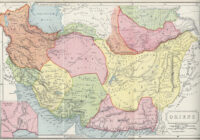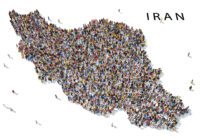In an interview, the head of Iran’s atomic agency seems to have suggested Tehran has used the JCPOA to develop its nuclear capabilities.
On February 18, the head of Britain’s MI6 intelligence agency visited Israel to discuss Iran’s nuclear activity. Amid concerns that Tehran may be preparing to breach the conditions of the 2015 agreement, the visit may have been prompted by the new information about the country’s nuclear program. On January 22, in an interview with Iranian TV, Ali Akbar Salehi, the head of Atomic Energy Organization of Iran (AEOI), revealed that “Iran has not removed the core of its Arak heavy water reactor nor poured cement into it.” It seems Salehi’s revelations could have been unintentional; Iranian media have since removed the interview, followed by a complete silence from the government.
In accordance with the Joint Comprehensive Plan of Action (JCPOA), Iran was required to fill the calandria — the core of the nuclear reactor — at the Arak facility with cement to render it unusable. Iran was also prohibited from acquiring metal tubes that can make reactors suitable for plutonium production. As such, the International Atomic Energy Agency (IAEA) Board of Governors released a report by its director general, confirming that Iran had removed, and rendered inoperable, the Arak facility’s calandria. At the time, Iran announced that Arak’s heavy water nuclear reactor had been filled with cement.
However, according to Salehi, “Iran removed the calandria from the Arak reactor and poured cement into metal tubes contained within fuel bundles.” This contradicts the terms of the nuclear deal that stipulated the removal of calandria and covering the core of Arak reactor with cement in order to curb Iran’s ability to advance its nuclear ambition. Moreover, according to the negotiations, Iran was prohibited from purchasing new calandria.
Nonetheless, Salehi went on to say that “Iran had bought extra metal tube equivalents, transferred them to a secret location, and Iran has been using them since then.” Under the terms of the JCPOA, it is prohibited for Iran to have access to open calandria, which is used for nuclear application. “Only myself and the supreme leader of Iran, Ayatollah Khamenei, knew about buying calandria secretly. Neither P5+1, nor Iranian negotiators knew about this” said Salehi. He continued: “The international community would have asked us to fill new metal tubes with cement as well. That is why we never told them that we had these metal tube equivalents. That is why we hid this from P5+1 and the International Atomic Energy Agency.”
Nuclear Achievements
The head of AEOI described the move as “maintaining the bridges — achievements in our nuclear program — and, more importantly, building new bridges for the future.” What was revealing in Salehi’s statement, raising suspicions about the effectiveness of the JCPOA, was that Salehi praised the fact that the nuclear deal gave Iran the ability to produce plutonium:
“The Iran Deal made it possible for us to get rid of the 60-year-old Russian-made reactor in Arak and redesign the reactor to produce plutonium. We could not produce plutonium used to make bombs with the old reactor we had. Prior to signing the deal, we had designed our own reactor, but we were not sure if it would work. One of our conditions was that P5+1 scientists certify our designed reactor and, because of the JCPOA, American and Chinese experts confirmed that our own designed reactor is accurate and will work. This was a significant achievement for us.”
However, in November 2017, secretary of state under Barack Obama, John Kerry, claimed that “Iran had the ability to produce plutonium.” Speaking at Chatham House in London, Kerry stated that “Iran was only two months away from making a nuclear bomb.” This claim has since been widely repeated in various global media, leading to the belief that Iran had the capability to produce plutonium. Now, if we are to believe Salehi’s words, this assertion seems to contradict the reality on the ground.
Nevertheless, Salehi did not mention whether Iran currently produces plutonium, nor did he mention the secret location of where the core and metal tubes are being used. Furthermore, during the JCPOA negotiations, Iran repeatedly refused to allow IAEA inspectors to visit the country’s Kurdish region. At the time, according to one of the members of P5+1, there were suspicions that Iran had a secret nuclear site in the Kurdish region — a claim repeatedly denied by Iran.
Nonetheless, the White House stated on its website that Iran agreed to allow the IAEA inspectors “to access and inspect any site they deem suspicious.” However, there is no indication of requests or visits to the Kurdish region in the IAEA reports. Consequently, on July 22, 2016, the Intelligence Organizations of the Islamic Revolutionary Guards Corps (IRGC), known as SAS, arrested a French and a British diplomat in the Kurdish region and seized their cameras. The IRGC released a warning to diplomats in Iran, stating that the “Kurdish regions are IRGC’s red line, without getting permission from the IRGC and accompanied by the IRGC forces, no diplomat can visit the region.”
A year later, in September 2017, one of the Kurdish opposition groups discovered one of the biggest secret IRGC sites in Iran. According to the report, the “site is built 400 meters underground, no one is allowed to go near the location, and the site is heavily secured by the IRGC forces for a five-mile radius.” It would appear significant that the location of this site is very close to where British and French diplomats were arrested. Yet the IAEA has never requested permission to visit the site.
New Capabilities
According to the latest reports by the Institute for Science and International Security (ISIS), Iran’s secret nuclear archive exposed by Israel “provides substantial evidence that Iran’s declarations to IAEA are incomplete and deliberately false.” Indeed, what Salehi revealed in his interview appears to confirm ISIS analysts’ report.
The IAEA has repeatedly confirmed that Iran is abiding by the nuclear deal. However, Salehi claimed that if “Iran withdraws from the deal, then Iran can take its steps much quicker than before.” If this is true, then the JCPOA has not curbed the regime’s nuclear capability, but has in fact facilitated the building of a new reactor for production of plutonium used in nuclear bombs — a capability Iran did not have before. Tehran had always managed to keep many aspects of its nuclear program secret, and it would appear it may have succeeded in doing so again.
In essence, it is difficult to verify if Iran has violated the nuclear agreement, as its activities remain secret, and the statements coming from by the former US administration and Iran’s top officials in charge of the nuclear program are contradictory. Nevertheless, recent revelations by the head of the Atomic Energy Organization of Iran give more weight to the current US administration’s claim that the Iran deal was indeed poorly negotiated.
The views expressed in this article are the author’s own and do not necessarily reflect Fair Observer’s editorial policy.
Support Fair Observer
We rely on your support for our independence, diversity and quality.
For more than 10 years, Fair Observer has been free, fair and independent. No billionaire owns us, no advertisers control us. We are a reader-supported nonprofit. Unlike many other publications, we keep our content free for readers regardless of where they live or whether they can afford to pay. We have no paywalls and no ads.
In the post-truth era of fake news, echo chambers and filter bubbles, we publish a plurality of perspectives from around the world. Anyone can publish with us, but everyone goes through a rigorous editorial process. So, you get fact-checked, well-reasoned content instead of noise.
We publish 2,500+ voices from 90+ countries. We also conduct education and training programs
on subjects ranging from digital media and journalism to writing and critical thinking. This
doesn’t come cheap. Servers, editors, trainers and web developers cost
money.
Please consider supporting us on a regular basis as a recurring donor or a
sustaining member.
Will you support FO’s journalism?
We rely on your support for our independence, diversity and quality.






